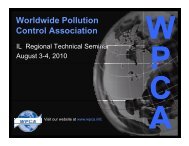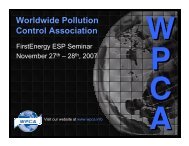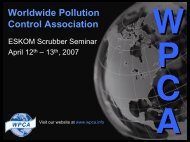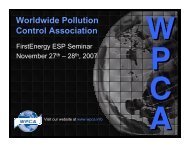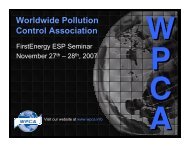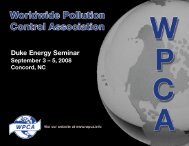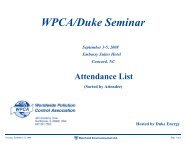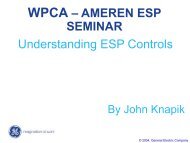SCR Catalyst Management - Wpca.info
SCR Catalyst Management - Wpca.info
SCR Catalyst Management - Wpca.info
You also want an ePaper? Increase the reach of your titles
YUMPU automatically turns print PDFs into web optimized ePapers that Google loves.
Ameren SeminarAugust 19–20, 2008Effingham, IL
2008 WPCA/AmerenESP and <strong>SCR</strong> SeminarEffingham, ILAugust 20, 2008Ceramics<strong>SCR</strong> <strong>Catalyst</strong> <strong>Management</strong>Ken Jeffers
Agenda• <strong>SCR</strong> <strong>Catalyst</strong> Basics• Background on <strong>SCR</strong> catalyst and design considerations• Provides basis for relevance of <strong>Catalyst</strong> <strong>Management</strong>• <strong>Catalyst</strong> <strong>Management</strong>2
<strong>SCR</strong> <strong>Catalyst</strong> BasicsCeramics
Quick Review of <strong>SCR</strong> BasicsFlue Gas: NOx, O2, SO2• <strong>SCR</strong> = Selective Catalytic Reduction• Purpose is to reduce NO x (NO & NO 2 ) fromcombustion exhaustNH 3• Ammonia (NH 3 ) is injected into flue gas asreducing agent. Flue gas passes throughcatalyst layers installed in a reactor• NH 3 reacts with NO x on the catalyst surfaceto form nitrogen and water vapor4NO + 4NH 3 + O 2<strong>Catalyst</strong>4N 2 + 6H 2 ON2, H2O, O2, SO2(SO3)2NO 2 + 4NH 3 + O 2<strong>Catalyst</strong>3N 2 + 6H 2 O4
<strong>Catalyst</strong> TypesPlate Honeycomb Corrugated6
Honeycomb <strong>Catalyst</strong>Composition• Homogeneously extruded ceramic withsquare-opening cell structure• TiO 2 , V-oxide and W-oxide asthe active catalytic material• Variable block height: 1200+ mm• 8 to 14 cpsi for coal-fired applicationsAdvantages• Ideal for low/no dust applications• High active surface area per unit volume8
<strong>Catalyst</strong> PitchPitch = center to center distance from one plate/wall to the nextpitchpitchPlate-Type Structure• Flexible plates• Rectangular Openings• Pitch: 5 mm to 7 mmHoneycomb Structure• Rigid structure• Square openings• Pitch: 6.7 mm to 9.2 mm9
Pitch Selection vs Dust LoadDust Loadgr/dscf12PlatePitch5.0 mm5.5 mm6.0 mm6.2 mm6.5 mmHoneycombPitch6.7 mm (22 Cell)7.4 mm (20 Cell)8.2 mm (18 Cell)9.2 mm (16 Cell)NA10
<strong>Catalyst</strong> Modules• <strong>Catalyst</strong> elements arranged in steel frames• Plate – 2 levels of 8 element boxes• Honeycomb – 72 monoliths• Standardized cross-section• Possible to interchange catalyst types withinreactor• Module height varies with catalyst height11
<strong>Catalyst</strong> Design Considerations• <strong>SCR</strong> Reactor• Initial catalyst charge or reload• Reactor size – layers, modules per layer• Plant configuration – high dust / low dust• Flue Gas Operating Conditions• Operating Temperature• Fuel Characteristics• Fly ash concentration• Performance Requirements• Amount of NO x to reduce and operating life• NH 3 slip allowed, 2 ppm standard• SO 2 oxidation allowed• Pressure drop limit, < 1.0” wc per layer12
Required Reactor Potential• Minimum catalytic potential required to achieve desired DeNO x andNH 3 slip rates for given operating periodRP =k tAVk t = activity at time t (EOL)AV = area velocityAV =V fgVol cat *A spec• <strong>Catalyst</strong> deactivates with time, k 0 k t (time at end of life)• Fresh catalyst activity, k 0 ,depends on<strong>Catalyst</strong> formulation V 2 O 5TemperatureFlue gas composition – H 2 O, O 2 , SO 2• Iterative process to determine required AV and k13
<strong>Catalyst</strong> Deactivation MechanismsMasking:Macroscopic blockageof catalyst surfaceby cemented fly ashCemented Fly Ash<strong>Catalyst</strong> SurfacePoreSystemPlugging:Microsopic blockage ofpore systemby small fly ash particles<strong>Catalyst</strong> SurfacePoreSystemSmall Fly Ash ParticlesPoisoning:Deactivation of activesites by chemical attack<strong>Catalyst</strong> SurfacePoreActive SitesSystem14
<strong>Catalyst</strong> Poisons• Arsenic – vapor phase As 2 O 3• Phosphorus – P 2 O 5• Alkali metals – Na, K15
Relative Activity, kt/k0• Initially (t=0), k t /k 0 = 1.0• k t /k 0 decreases with time (exponentially decaying model)• Characteristic of <strong>SCR</strong> configuration, fuel, deactivationmechanisms.• Obtained from catalyst activity monitoring• Have k t k 0 or have k 0 k t0.50 - 0.55ApplicationLow dust configBituminous firingPRB firingLignite firingtime, hr16000160001600016000k t /k 00.80 - 0.850.70 - 0.750.65 - 0.7016
Effects of Sulfur in Fuel• SO 2 oxidation, undesired side reaction in <strong>SCR</strong> catalyst2SO 2 + O 2 2SO 3• Rate depends on T and catalyst formulation• Occurs in the bulk mass of catalyst materialSO 3 /H 2 SO 4 aerosols cause the “Blue Plume”• SO 3 reacts with NH 3 to form ammonium bisulfate (ABS) and ammoniumsulfate (AS)NH 3 + SO 3 + H 2 O NH 4 HSO 4 (ABS)NH 4 HSO 4 + NH 3 (NH 4 ) 2 SO 4 (AS)2NH 3 + SO 3 + H 2 O (NH 4 ) 2 SO 4 (AS)• AS is dry, powdery compound• ABS is sticky, viscous compound that can plug catalyst and foul otherequipment17
SO2 Oxidation – Influence of V2O55RelativeActivityRelativeOxidation Rate5443k NOx32k SOx211000 0.2 0.4 0.6 0.8 1.0 1.2 1.4V 2 O 5 content [wt-%]18
Minimum Operating Temperature, (Tmin)• Minimum temperature for NH 3injection• Of particular concern for low loadoperation and firing fuelscontaining sulfur• Operating above T min preventsAS/ABS formation• Tmin depends on SO 3 , NH 3 , H 2 Oin flue gas• Must stop NH 3 injection whenoperating below TminTmin (F)625600575550Tmin vs SO 3 inletNOx in 250 ppm, 88% DeNOx, NH 3 Slip 2 ppm12% H2O10% H2O8% H2O5250 5 10 15 20 25 30SO 3 inlet (ppm wet)19
<strong>Catalyst</strong> <strong>Management</strong>Ceramics
<strong>Catalyst</strong> <strong>Management</strong> Goals• Maintain target NO x reduction of the <strong>SCR</strong> system• Control NH 3 slip below required limit• Replace activity potential lost to catalyst deactivation• Optimize use of catalyst activity potential• Conform catalyst replacements to plant outage schedule• Conform to plant budgetary constraints• Maximize operating life between catalyst replacements• Prevent excessive pressure loss21
<strong>Catalyst</strong> <strong>Management</strong> Plan (CMP)• Schedule for maintaining <strong>SCR</strong> catalytic potential for NO x reduction• Process of adding, replacing, cleaning catalyst• Tailored to fit unit performance based on activity monitoring22
CMP, 2 + 1 ExampleRelative ReactorPotentialNH 3 slip(ppm)1.00.8Minimum potential forDeNOx, NH3 sliprequirements0.620.410.20 20,000 40,000 60,000 80,000 100,000Operating Time (h)23
Activity Monitoring• Routine catalyst activity testing• Once per year (typically)• Pull samples from each installed catalyst layer• Determine relative activity compared to fresh catalyst• Determine rate of catalyst deactivation• Predict when reactor potential reaches minimum level• Verify or adjust CMP schedule24
CMP Actions• Install new catalyst• Onsite (in situ) Cleaning – removing fly ash/LPA buildup• Vacuuming• Air blowing• Shaking/vibration• Water washing• Rejuvenation – onsite or offsite washing/chemical treatment• Remove ash/particles from catalyst pores• Remove water soluble poisons• Regeneration – offsite chemical treatment• Remove chemically bonded poisons – As, P• Replace active catalytic material25
Pros/Cons for CMP OptionsCMP ActionProsConsNew <strong>Catalyst</strong>(<strong>Catalyst</strong> Supplier)Longest operating lifePerformance guaranteesHighest Cost OptionCleaning(by Owner)Rejuvenation(Service Supplier)Regeneration(Service Supplier)Low(est) cost optionCan be done in situLower cost than new catalystCan be done onsiteLower cost than new catalystCan restore to “new” activityLowest activity restorationLimited extension of lifeDoes not restore to “new”activity, limited life extensionPerformance guarantees?Done offsite, may need sparecatalystMay increase SO 2 conversionPerformance guarantees?26
Considerations for CMP Options• CMPs are unit-specific• Economic Trade-offs: New vs Regen• Lower cost for Regen, shorter operating life• Higher cost for New, longer operating life• Spare catalyst layer on-hand may be required to replace catalystremoved for regen• <strong>Catalyst</strong> supplier offers performance guarantees for new catalyst• Does regen supplier offer guarantees for Regen’d catalyst?• Consider which options conform best to plant outage schedule• Cleaning/rejuvenation may not extend catalyst life to next outage• Consider operation with lower DeNO x , higher NH 3 slip• Consider impact to plant emission standards27
<strong>Catalyst</strong> Mixing• Standardized module structure – catalyst mixing is possible and common• Multiple catalyst types in reactor• New and regen’d• Multiple suppliers• Consider tooling requirements• Lifting, transport tooling for unloading/loading• Sealing systems• Performance Guarantees from new supplier (other than initial)• Layer guarantees – geometry, durability, activity, SO 2 conversion,pressure drop – based on fuel and flue gas characteristics• System guarantees – DeNOx, NH 3 slip, operating life – based on totalreactor potential requires <strong>info</strong> about existing catalyst28
Required Info for Existing <strong>Catalyst</strong>• Geometry• <strong>Catalyst</strong> type• Volume• Specific area, m 2 /m 3• Activity Trends• Fresh catalyst, initial activity – k 0• Relative/absolute activity after exposure to flue gas• Age of catalyst at time of testing• Above <strong>info</strong> used to . . .• Calculate existing reactor potential• Determine rate of deactivation• Develop CMP29
Plant Operation Considerations• Control Ash buildup• Sootblowers/Sonic horns• Cleaning/vacuuming during outages• Uniform NH 3 /NO x distribution• AIG Tuning• Maintain NH 3 injection nozzles• Limit injecting NH 3 below Tmin• Short time operation OK (< 8 hr, 100 hr/yr)• Period below Tmin must be followed by higher Temp operation (>350 °C for 8hours)• Effects of Operating changes on <strong>SCR</strong> performance• Fuel changes• Economizer modification30
Thank You!Ken JeffersApplication Engineer, <strong>SCR</strong> <strong>Catalyst</strong>ken.jeffers@argillon.com678 341 7523Argillon LLC5895 Shiloh Road, Suite 101Alpharetta, GA 30005www.argillon.com31



